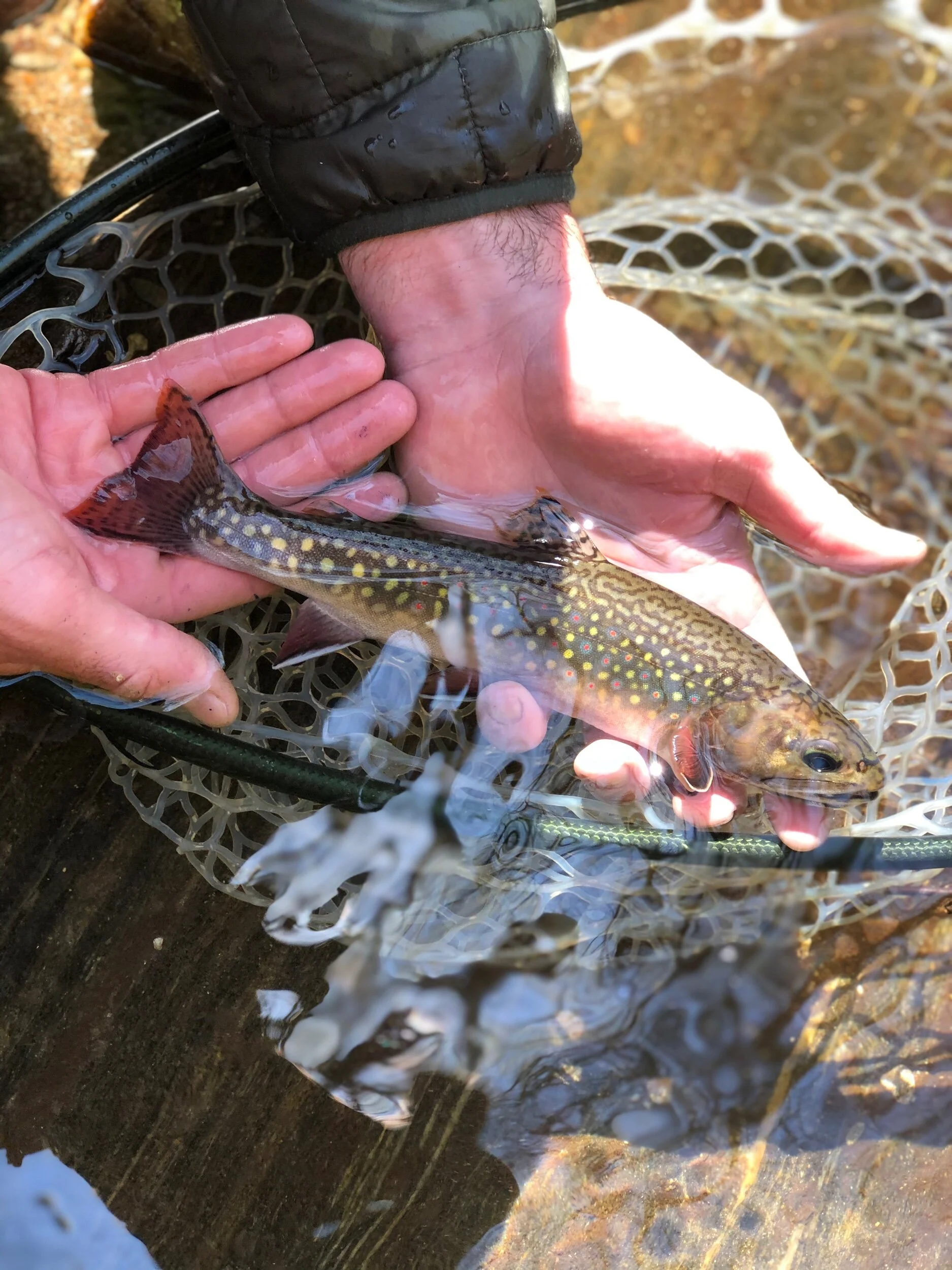A Native Fish of North Carolina.
North Carolina Wild Brook Trout
The Southern Appalachian brook trout is North Carolina’s only native trout. Scientifically speaking the brook trout is actually a char. These beautiful fish are the only species of the salvelinus family that has worm-like markings called vermiculations on its back, dorsal fin, and tail.
Up close picture of the vermiculations on the brook of a stocked brook trout here in NC.
The wild brook trout of North Carolina live in high altitude streams, creeks, and branches where the elevation is 2,500 feet or higher. These fish thrive in the headwaters of mountain streams where the water is cold, clean, and rich in oxygen. The presence of wild brook trout in the headwaters of a stream represents the health of that particular body of water. If the source of a stream is healthy it is a good indicator for productive water downstream as well.
The mountain region of McDowell County has numerous wild brook trout fisheries.
McDowell County borders very large tracts of National Forest land that is home to some great brook trout fisheries. These streams require some bushwhacking and rock climbing, but catching and releasing one of these highly prized fish is well worth the effort. I’ve caught wild brook trout in 6 of the higher elevation creeks, streams, and branches in Old Fort. These streams fish best from late February to September. The wild brook trout will begin to spawn late September to November so it’s best to leave them alone during this time. Successful yearly spawns are an integral part of future brook trout populations in our mountain streams. Leave them alone!
Headwaters of a healthy mountain stream.
Fly fishing for wild brook trout in Newberry Creek.
The Comeback Fish
In the late 1800’s and early 1900’s the invasive logging practices in the mountains of North Carolina had a devastating effect on wild brook trout populations. Logging companies stripped the virgin timber on most hillsides which led to the construction of roads, railways, and splash dams to send logs downstream. These practices clogged mountain streams with silt and mud which hindered the brook trout from successfully spawning. Eliminating the trees caused erosion issues and water temperatures to warm because the canopy of trees provide much needed shade to keep water temperatures suitable for the trout. After the damage was done people realized how the intensive logging practices had hurt the brook trout fisheries, so they ended up stocking rainbow and brown trout to replace the native fish. The native brook trout that remained could not compete with the introduced fish. This isolated the brook trout into the headwaters in which they are found today. Since 1900, it is said that the native brook trout range has declined by 80 percent. Fortunately, the North Carolina Wildlife Resource Commission and Trout Unlimited have been restoring brook trout populations since the 1990’s, so we are seeing some great results. The history of the brook trout in their native region was in turmoil, but this has shown their resiliency and how a resource can heal itself if left alone. These native fish are a true gem to our local waters.
Stalking wild brook trout on the fly.
Most wild brook trout are 6-8 inches, but this one was close to 11 inches.
Tips for catching wild brook trout
Find streams, creeks, and branches where brook trout call home. Most of these fisheries are ones that are 2,500 feet or higher in elevation. Most of these fisheries receive little pressure which makes for some great fishing!
Use smaller fly rods and reels. These smaller rods help when you have heavy cover above you when casting. Smaller setups make for a better fight and are appropriate for these smaller fish. I recommend using a 1-3 weight rod and reel with a 7.5 foot 5x leader.
Fishing is best in the Spring and Summer. If you go fishing in the summer make sure you land the fish quickly and release it quickly. The best times to fish in the summer is early morning when water temperatures are lowest.
Brook trout aren’t very selective when it comes to flies. I would recommend using a caddis or parachute adams fly. Either one will work when presented correctly.
Common flies used to target wild brook trout.
Brook Trout Adventures with The Catawba Angler
Guided Trips for Wild Brook Trout
The Catawba Angler provides guided trips for wild North Carolina brook trout. These trips aren’t for the faint of heart so if you are up for the challenge of hiking into a remote location and targeting our mountains most treasured fish then give us a call. It truly is an honor to catch and release one of these fish once you know the history behind them. These fish live in the most beautiful places in North Carolina and I take a lot of pride in being able to share this resource with people from all over. After each trip, I can only hope that the clients leave with as much respect that I have for these fish. There is plenty of conservation work surrounding the brook trout, so I encourage every angler to get involved and help protect these fish and their homes.
All guided trips are catch and release only because the future of our sport is in our hands.












